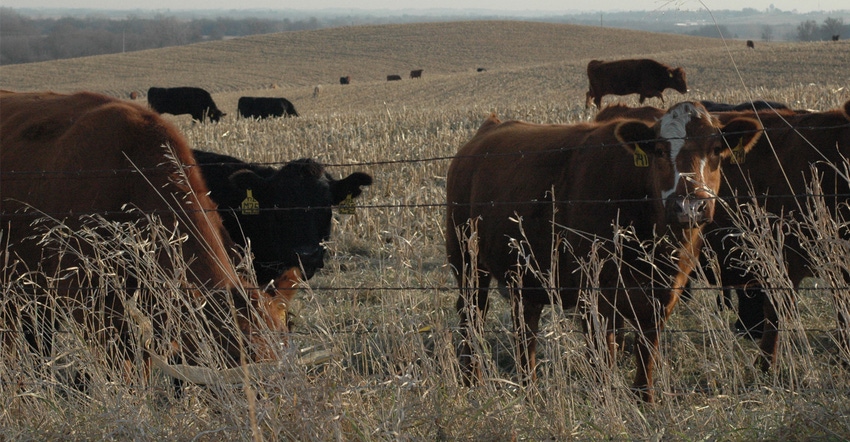March 29, 2018

The U.S. and Canada historically have had relatively unrestricted trade in livestock and meat. American producers and other market participants should watch Canadian supplies, as production trends there have a direct impact on the U.S. markets.
Mexican livestock numbers are somewhat more opaque. But they’re also an important part of the picture, given the significant number of Mexican feeder cattle flowing into U.S. feedlots and sizable U.S. beef and pork exports to Mexico.
Joint publications from USDA’s National Ag Statistics Service and Statistics Canada report inventories every March and August. One report is for U.S. and Canadian cattle and sheep, and the other report is for U.S. and Canadian hogs. The reports show each individual country’s inventories, plus a combined total. American cattle and hog industries requested this data to provide producers additional information about potential supplies.
Canadian cattle sector struggles
The general theme in the U.S. cattle industry over the last several years is numbers are rising. Expansion may continue for another year or so. However, if we zoom out just a bit, the same can’t be said for our partners to the north. The latest Canadian cattle numbers show some minimal growth. But Canada isn’t seeing the kind of expansion trajectory as in the U.S.
Total cattle inventory in Canada as of Jan. 1 was estimated at 11.625 million head, which is 105,000 head (0.9%) higher than Jan. 1, 2017. Despite that rise, Canadian cattle inventories are still 615,000 head smaller than the last peak in 2013, and 3.3 million head smaller than the peak in 2005.
Profits have encouraged U.S. cow‐calf producers to expand over the last several years. But that hasn’t been the case in Canada. The Jan. 1 Canadian beef cow herd was estimated at 3.710 million head, up less than 1% from a year earlier (just 29,500 head larger) and down 1.574 million head (30%) from the peak in 2005.
Canadian producers have been retaining more heifers for beef cow replacement since at least 2011, but that has had little impact on overall beef cow numbers in Canada. High cattle prices in the U.S., especially cow prices, and a shift in exchange rates have helped pull Canadian cows and bred heifers into the U.S.
Some modest herd rebuilding in Canada reduced the supply of cattle that came to the U.S. in 2017. Imports may stay low in 2018. In the last nine reported weeks, total shipments of Canadian slaughter steers and heifers, slaughter cows, and breeding females are down 9,395 (18.9%), 10,009 (38.5%), and 1,568 head (57.8%), respectively, from the same period a year ago.
So far this year, feeder cattle imports from Canada are up 8,397 head (47.1%), but that’s after a 61,687-head (34.5%) decline in 2017.
The direct result of a smaller Canadian breeding herd is a steady erosion in calf production and ultimately a smaller Canadian cattle industry. The decision by Western Feedlots, Canada's largest feeding operation, to wind down operations in 2017 resulted from the realization that a structural turnaround is unlikely in the short to medium term.
With Canada’s 2017 calf crop 1.106 million head smaller than the 2005 crop, Canada’s supply base is about 20% smaller. Plus, Canadian feeders also have to contend with strong competition from U.S. feedlots for feeder cattle and the negative impact of a weak exchange rate at times.
Pork more promising for Canadians
While the Canadian cattle industry may be, at best, stabilizing, the Canadian pork industry appears to have found some legs. The total inventory of hogs and pigs as of Jan. 1 was 14.325 million head, 380,000 head (2.7%) larger than a year ago.
The breeding herd has been slowly growing, gaining another 1.3% in 2017 compared to the year before. The growth in the size of the breeding herd and continuing improvements in productivity (more pigs per litter) sets the stage for further expansion in North American hog supplies.
Most of the live hogs that come to the U.S. are Canadian feeder pigs, which are finished in U.S. barns. This used to be a much bigger business, but the Canadian breeding herd shrunk by about 27% between 2005 and 2014. An increase in feeder pig imports from Canada the last several years has been influenced by an increasing breeding hog inventory in Canada, and generally facilitated by exchange rates.
In 2015 and 2016 feeder pig imports from Canada increased 394,863 head (10.2%) and 316,219 head (7.4%) year over year, respectively.
Current expansion in Canada may not however be an impetus to further bolster the supply of feeder pigs that enter the U.S. market. Last year, Canadian feeder pig imports only rose 13,844 head (0.3%) compared to the 2016 levels. Through the first nine reported weeks in 2018, total shipments of Canadian feeder pigs into the U.S. are down 54,359 head (6.5%) from the first nine weeks in 2017. Profitability may be keeping more feeder pigs in Canada.
Schulz is the Iowa State University Extension livestock marketing economist.
About the Author(s)
You May Also Like






